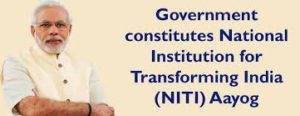NITI Aayog- The National Institution for Transforming India
What is NITI Aayog or The National Institution for Transforming India?
NITI Aayog or The National Institution for Transforming India is a Government of India establishment. It was formed vide a resolution of the Union cabinet on 1 January 2015. NITI Aayog was founded to substitute the planning commission established in in1950. The establishment is expected to develop itself as a State of the Art Centre of excellent resources and knowledge to provide strategic inputs to the government in policy decisions and handling contingent challenges.
What are the roles envisaged for NITI Aayog or The National Institution for Transforming India?
NITI Aayog, is promoted as an apex policy ‘Think Tank’ for
• Providing strategic directional and policy inputs to the Government of India.
• Developing long term strategic plans and programmes for Government of India.
• Extending relevant technical advice to central and state governments.
• Better serving the demands and aspirations of an India that is on the path of development and
• Ensuring participation of states in national interest with the aim of fostering co-operative federalism.
What are the key tasks of NITI Aayog or The National Institution for Transforming India?
There are two hubs for carrying out the two major tasks of NITI Aayog. Team India Hub ensures the first task of engagement of states with the Central government. Developing the Think tank capabilities, the second task, is being handled by the Knowledge and Innovation Hub.
Who are the members of NITI Aayog?
NITI Aayog has the Prime Minister as the Ex-officio chairman. Its governing council consists of all state Chief Ministers, Lieutenant Governors of union territories, and vice chairman nominated by the Prime Minister. Apart from full time members there are two part-time members and four ex-officio members and a chief executive officer. The selection of temporary members is from universities and research institutions of repute. These members are of excellent credentials.
What was the Planning Commission?
Planning Commission was established on 15 March 1950. It was formed as an arm of Central Government of India. The commission was reporting directly to the Prime Minister, the chairman of the commission.
Formulation of five year plans in consultation with Central ministers and State governments and their implementation were the major roles of Planning Commission. Other functions included
a. Assessment of the material, capital and human resources of the country and formulating plans to meet deficiencies.
b. Plan strategies for the most effective and balanced utilization of the country's resources; and
c. Ensuring co-operation of public in national development.
The first Five-Year Plan was launched in 1951 with focus on agricultural sector development. First eight plans focused on the growth of public sector with massive investments in basic and heavy industries. This was essential as investment in basic infrastructure required huge investment and individuals or small companies in the country were not capable of meeting such heavy investments. Thus the commission needed to follow a top-down model. Due to the vision and selfless service of earlier leaders, the country has become one of the fastest growing countries in the world. Hence a relook was needed in the roles of Planning Commission. NITI Aayog or The National Institution for Transforming India was launched in these circumstances. So far 12 five year plans were carried out by the commission.
What are the major differences between NITI Aayog and Planning Commission?
a. NITI Aayog functions as a think-tank forum in contrast with the Commission which was powerful enough to impose five-year-plans and allocate resources
b. NITI Aayog functions on a bottom-up approach instead of top-down approach of the commission.
c. The new forum will include leaders of India's 29 states and seven union territories apart from temporary members selected on the basis of proven credentials.
d. The ruling BJP party had promised to do away with the Planning Commission if elected to power.
e. The Planning commission was set up to focus on development of India's agrarian economy and basic infrastructure for industry.
f. The commission had become powerful over years and emerged as a sort of parallel cabinet with the Prime Minister as its head.
g. The way of allotment of funds by the commissions was often ended in criticisms by states and various government departments. ISRO – Indian Space Research Organisation










